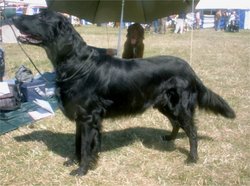
|
From Wikipedia the free encyclopedia, by MultiMedia |
| Flat-Coated Retriever | ||
|---|---|---|

|
||
| Alternative names | ||
| Country of origin | ||
| United Kingdom | ||
| Common nicknames | ||
| Flatcoat | ||
| Classification and breed standards | ||
| FCI: | Group 8 Section 1 #121 | |
| AKC: | Sporting | |
| ANKC: | Group 3 (GunDogs) | |
| CKC: | Group 1 - Sporting Dogs | |
| KC (UK): | GunDog | |
| NZKC: | GunDog | |
| UKC: | Gun Dog Breeds | |
| Not recognized by any major kennel club | ||
| This breed of Dog is extinct | ||
| Notes | ||
The Flat-Coated Retriever is a gunDog breed from Britain. It is a specialist dry-land retriever.
The breed stands 22 to 23 inches (56-58.5 cm) and weighs 60 to 70 pounds (27-32 kg). Its colour is either solid black or liver, more commonly the former. Flat-Coated Retrievers have muscular jaws and a large snout with an undefined forehead. The ears are floppy and relatively short.
The coat is moderate in length, dense, and lustrous; ideally it should lie flat and straight, but the breed was initially called the Wavy-Coated Retriever. Later, the coat somehow flattened out and the name changed accordingly, but the tendency toward wavy hair still emerges occasionally.
The flat-coat’s personality is described as outgoing, devoted, and friendly, an ideal companion with a strong bond to its owner. It is said to be a very versatile hunting Dog, retrieving well on land or in the water, flushing upland game, marking downed birds, and generally doing all that can be expected of a multipurpose gunDog. Although little-known and much less popular than the Labrador and Golden Retrievers, it has benefitted from that lack of popularity by enjoying more careful breeding and better maintenance of its fine working ability.
Flat-coated retrievers love to please, but may be slightly more difficult to train than the popular Golden Retriever and Labrador Retriever. They exhibit a streak of willfulness at times, and don't have a really long attention span. For this reason, it's best to make training sessions fun, entertaining, and relatively short for the Dog.
Flat-coats are known for having a sunny optimism and a tail that's always wagging. They are capable of getting along well with cats, other Dogs, small pets, and strangers. However, due to their exuberant nature, they may tend to knock over chldren. Socialization and obedience training is highly recommended. Flat-coats tend to be very rowdy when young, and need plenty of exercise throughout their life. Sometimes they are referred to as the "Peter Pan of Dogs" because they never grow up, acting playful and puppy-like well into their years.
Originating in the late 19th century it gained popularity as a gamekeeper’s Dog. Part of its ancestry is thought to have come from stock imported from North America of Newfoundland type, as was the case with the Labrador and Chesapeake Bay retrievers.
After its introduction, the flatcoat began to quickly gain in popularity as a gunDog, and from 1873 when the breed became a "stable type" according to the American Kennel Club until 1915 when it was officially recognized as a breed, the number of flatcoats grew rapidly. However, soon thereafter, the popularity of the flatcoat began to fall, eclipsed by the golden retriever, which was actually bred in part from the flatcoat, and other breeds. By the end of World War Two, there were so few flatcoats that the breed's survival was uncertain. However, beginning in the 1960s, the breed gained in popularity again, and today, the flatcoat remains a solid breed.
Dogs, made by MultiMedia | Free content and software
This guide is licensed under the GNU Free Documentation License. It uses material from the Wikipedia.